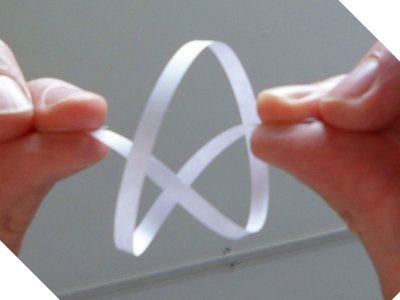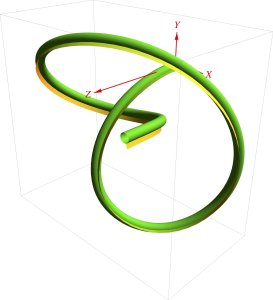Knots are widespread, universal physical structures, from shoelaces to Celtic decoration to the many variants familiar to sailors. They are often simple to construct and aesthetically appealing, yet remain topologically and mechanically quite complex.
Knots are also common in biopolymers such as DNA and proteins, with significant and often detrimental effects, and biological mechanisms also exist for 'unknotting'.
There are numerous types of questions when studying knots. From a topological standpoint, fundamental issues include knot classification and equivalence of different knot descriptions. In continuum mechanics and elasticity, a knot is a physical structure with finite thickness, and aspects of interest include the strength, stability, equilibrium shape, and dynamic behaviour of a knotted filament. Such aspects are strongly connected to points/regions of self-contact, at which distant points push against each other.
Consider a simple hand-held experiment: take a strip of paper or flexible wire, tie it into a standard but loose knot (an open trefoil), and you will observe 2 isolated points of self-contact surrounding an interval of self-contact. Now add twist by rotating the ends, change the end-to-end distance by bringing your hands closer or further apart, and combine with small transverse displacements, i.e. shifting the end. For certain materials and with a little finesse, all points of contact can be removed.
Such configurations – contact-free, knotted, and mechanically stable – have never been described before, and Oxford Mathematician Derek Moulton and colleagues sought to understand and characterise them in terms of the underlying geometry and mechanics. To do so, they turned to the Kirchhoff equations for elastic rods, a set of 18 nonlinear differential equations that describe the balance of forces and moments as well as the geometrical shape of a thin and long elastic material. These equations admit an incredibly rich and non-unique solution space. A small modification to these equations yields the 'ribbon equations', more appropriate for a strip of paper and with a similarly complex solution space.
The goal was to find configurations within this solution space that satisfy the conditions of being contact-free, mechanically stable, and knotted. This was a bit like finding a needle in a haystack, but after applying some numerical tricks they showed that in fact such configurations exist as theoretical solutions of the full nonlinear 18D system; they then categorised the space of 'good knots' in terms of the 3 experimental measures: end-rotation, end-displacement, and end-shift. The numerical study was complemented with an asymptotic analysis of a perturbed 'double ring' solution; the idea being that knotted solutions can be found in the neighbourhood of a planar circle that overlaps itself exactly once.
The analysis suggests that the transverse displacement is a necessary component for generating contact-free knots. While the researchers only considered the "simplest" trefoil knot, they conjecture that toroidal knots of increasing genus can be stabilised in a contact-free state.
For a fuller explanation of the team's work please click here.



